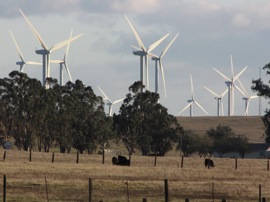How much wind energy do we need to make California’s goal of 33% clean electricity by 2020? Whenever I put this question to one of the experts, the answer is always: “It depends.” But under almost any scenario, thousands more windmills will dot the California landscape in years to come.

Those who don’t see them on a daily basis might be surprised to learn that there is already something on the order of 13,000 commercial wind turbines operating in California. Ryan Wiser, who tracks wind energy trends at Lawrence Berkeley National Lab, does a rough calculation that meeting that state-imposed threshold of 33% renewable energy could take 5,000 more, in order for wind to do its share. That’s based on an estimated 10,000 megawatts of new wind power, using the current standard two-megawatt turbine. While most of these will be concentrated in a few major “wind resource areas” (there are currently four big ones in the state), numbers like that almost ensure that wind turbines will become a more familiar feature of the California landscape.
If fulfilling the California dream for renewable energy takes thousands of turbines, a full-on decarbonization of the world’s energy production will take millions.
Those numbers don’t faze Mark Jacobson in the least. Recently when President Obama raised eyebrows with his goal of getting 80% of the nation’s electricity from “clean” energy sources by 2035, the Stanford engineer was just about to publish a paper that upped the ante, writing in an email to Climate Watch that “the clean energy should not only apply to the electricity sector but also the transportation, residential heating/cooling, and commercial heating sectors.”
Jacobson’s vision is that all new energy needs around the globe could come from a combination of wind, solar, and water-driven energy…by 2030. Of course, we’d be talking about planting four million wind turbines around the world, as well as 90,000 solar plants. Jacobson then laid out a “path” to his vision It seems at odds with the President’s broad definition of “clean,” which includes nuclear power and coal power with carbon capture:
First, right now investment is focused on too many options, most of which (e.g., natural gas, coal with carbon capture, biofuels, nuclear) are either not beneficial or less beneficial than clean wind, water, and sun (WWS) technologies. The spending of money on the less-efficient technologies is an opportunity cost wasted given the limited amount of funds available. Wind results in 50 times less carbon emissions than coal with carbon capture (“clean coal”) and orders of magnitude less air pollution than “clean coal” (“clean coal” actually increases air pollution over current coal since 25% more coal is needed to run the carbon capture equipment, and the equipment doesn’t reduce other pollutants aside from carbon dioxide).
No prudent businessperson would spend money on an investment that yields 50 times less money, so why should policy makers favor a technology that results in 50 times more carbon and much more air pollution than that?
Second, policies need to be put in place to correct the distortion of the current market mechanism that provides subsidies to fossil fuel and biofuel energy sources even though these sources cause health, climate, and other environmental damage, increasing health insurance costs, health effects, and taxes for all of us. By first eliminating such subsidies and second, instituting a revenue-neutral carbon and air pollution tax or something similar (a tax on these industries to account for their externality costs to society, where the proceeds are used to subsidize clean-energy industries — this would shift incentives toward production of clean energy systems with no net individual taxpayer cost.)
The full paper, which Jacobson co-authored with UC Davis professor Mark Delucchi, is published in the journal Energy Policy.
Hear my two-part radio series on wind energy in California, on The California Report. It and all reports in our series, “33 x 20: California’s Clean Power Countdown” are archived on our special series page. “33 x20” is a collaboration with KQED’s Quest science unit.
3 thoughts on “Wind Farm Forecast: More & Bigger”
Comments are closed.


Hi Craig,
I enjoyed your report this morning on wind power and renewables in California. It was very informative and important for the public to hear about the efforts made to move to a more sustainable energy portfolio. One observation (very minor): in your presentation, I kept hearing the reporter refer to “turbans” – for a moment, I could not understand the reference. Was the reporter referring to “turbines?” It struck me as a bit off-message.
Thanks for your attention.
Richard
Both pronunciations of “turbine” are acceptable; either “TUR-bin” or “TUR-bign.” I’ve listed them here in the same order as both the American Heritage and Merriam-Webster dictionaries. I realize that a lot of people prefer the latter but none of the industry experts I interviewed (not one) used the long “i.” Where are you from? The preference might be regional.
Wind turbines–a wonderful concept for energy, but not unless they are properly designed to eliminate bird and bat kills. There are wind turbines that are safe with open cages like fans sold to the public have and there are other ways of collecting wind energy besides wind turbines. Someone mentioned that “only” 30 thousand bird deaths have been documented by wind turbines and that thousands more are killed by cats and striking windows, etc. The fact is that there are so many undocumented kills by wind turbines that it is astounding. NOW is the time to use wind and do it responsibly–why is this not a priority for all environmental groups? Why don’t we care about the bat deaths????
Let’s really do it right!